Quick search
CTRL+K
Quick search
CTRL+K

Baku is the Azerbaijani capital which is beautifully located on the south coast of the Absheron Peninsula, which is surrounded on both sides by the Caspian Sea. The sea is actually a large lake that, however, seems like a sea off the coast of Baku and from the main roads along the coast.
The Baku Boulevard promenade stretches along the lakeshore, and there is always activity and wonderful outdoor life under the trees and the atmospheric lights from the lampposts. The boulevard connects not only the city and the water, but also many of the city’s sights with the old inner city as one of the gems.
One can easily imagine the historical life of the inner city’s low and dense buildings. Old hostels for the Silk Road caravans are here, as well as beautiful bathhouses, mosques, palaces and market streets; and it can all be seen from the top of the Maiden Tower, which stands as one of old Baku’s landmarks.
Baku is also oil. Everywhere in the area there are drilling towers on land, and also in the Caspian Sea, the black gold is here in quantities that over time have created enormous wealth to people and the state. It is seen in many of the town’s mansions from the time of the oil barons, and the amazing Flame Towers in modern design are visible and impressive signs of the country’s oil wealth.
There are rock carvings, drill towers, mud volcanoes and lovely beaches around Baku; all within close distance to the capital. The oil is everywhere, and that in itself is an experience to see when i.e. burning mountains have had non stop fires for years.
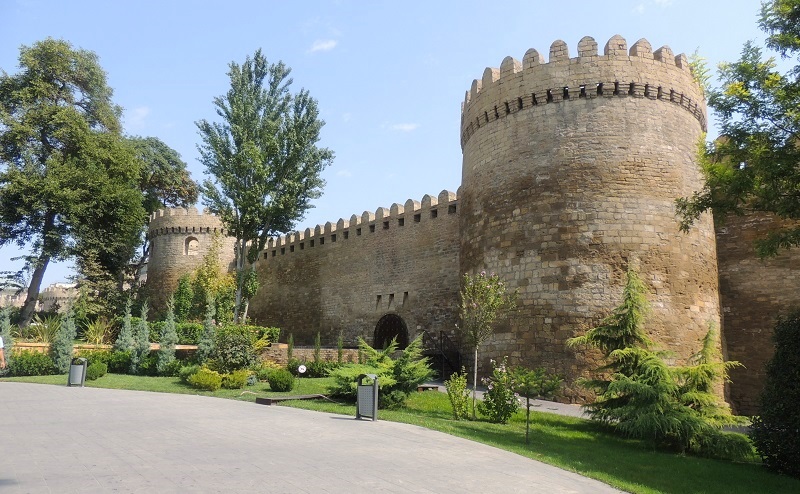
Baku’s inner city is called İcheri Shəhər in Azerbaijani, and it is another term for the old town, which is still surrounded by largely preserved city walls from the 12th century, where the impressive main gate is to the north. The district is included in UNESCO’s list of world cultural heritage and a trip here is like stepping several hundred years back in time.
Behind the encircling walls lies a jumble of small streets that offer a good atmosphere between, among other things, palaces, mosques, minarets, bathhouses and the inns for travelers, the so-called caravanserai, of which there were nine in the city. You can also see the old market place Bazar meydanı, which was established in the 12th and 13th centuries.
Up until the beginning of the 1800s, the entire population of Baku lived in Icheri Şəhər behind the walls. At that time, there were a total of around 7,000 inhabitants and just over 700 shops and workshops, and Icheri Şaher was divided into neighborhoods, each named after a local mosque. After Baku’s incorporation into the Russian Empire, European-style buildings were erected, creating an architectural mix that can still be seen today.
Baku Boulevard is a fashionable promenade that runs along the shores of the Caspian Sea and Neftçilər prospektı street. Historically, the coastline was artificially created here, where Baku’s oil barons built their luxury residences. At first there were mansions on one side and bar land and water on the other, but with the addition of huge amounts of land, the current park and promenade was created. The soil came, among other things, on ships from Iran, which from the 1880s legally had to bring soil for filling if they needed to use Baku’s port.
Eventually there was enough land, and the promenade, which is locally called a park, is today several kilometers long and is continuously being expanded these years to bring the city closer to the sea and the recreational opportunities that are along the coast.
There are several notable buildings along Baku Boulevard. You can see, for example, the Puppet Theatre/Kukla Teatrı (Neftçilər prospekti, 36) from 1912, which was originally a cinema, casino and restaurant complex, the Parachute Tower/Paraşüt Qülləsi (Neftçilər prospekti) from 1936 and the Azerbaijan Carpet Museum/Azərbaycan Xalçası Muzeyi (Neftçilər prospekti, 123), whose building was ready in 2011. The park of the boulevard also offers several attractions that lie like pearls on a string along the boulevard.
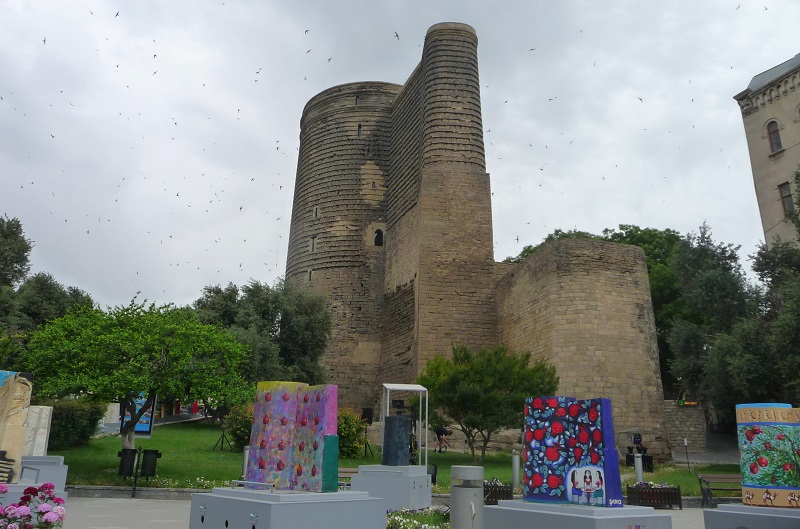
Qız Qalası is for many Baku’s best-known building, and it is often seen as one of Azerbaijan’s national landmarks. It is believed to have been built sometime in the 9th-12th centuries as part of Baku’s walls, and the Maiden’s Tower is today included on UNESCO’s list of world heritage sites.
The diameter of the tower is 16.5 meters at the base and it is 29.5 meters high. The walls are 3-5 meters thick. It originally stood on the coast of the Caspian Sea, but land reclamation in the 20th century has changed that, so that there are now roads and a promenade area between the coast and Qız Qalası.
There is a city history museum in the tower, which you can also go up in. From the top there is a lovely view with, among other things, a very nice look over the old town’s narrow streets, minarets and dense buildings. There is also a fine view over Baku Bay.
On the trip between Baku airport and the center of the city, the Haydar Aliyev Center stands as one of the city’s modern architectural highlights. With its undulating shapes and sharply rounded elements, the center is a striking building. The construction of the large facility lasted from 2007 to the inauguration in 2012, and it was the architect Zaha Hadid who designed the exciting place.
The center was named after the head of state of Azerbaijan Heydar Aliyev and is one of the spearheads of Baku’s cultural life. Here, there are continuous major exhibitions, concerts, meetings and other things with a greater perspective.
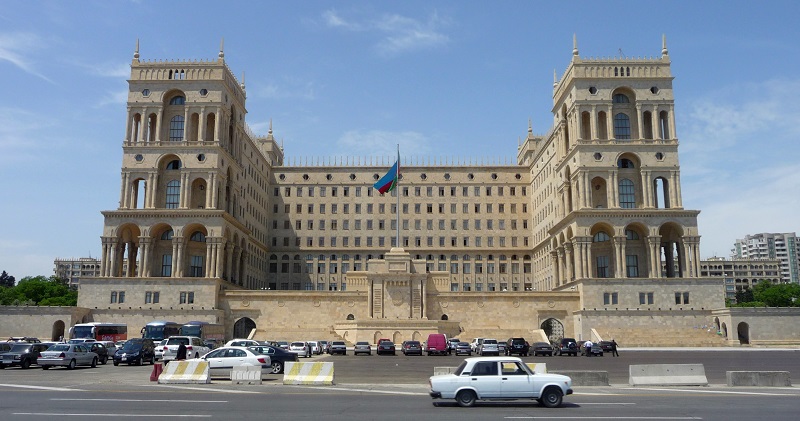
The government building is Baku’s former Palace of the Soviets, which was built in the years 1936-1952. The monumental, four-towered building was supposed to symbolize Soviet power and capability. After the dissolution of the Soviet Union, the building ceased to function, and today a number of government offices and various institutions are located here.
Freedom Square (Azadlıq meydanı) in front of the Government Building was formerly called Lenin Square, and from 1955 there was a statue of the Soviet leader, Vladimir Lenin, here.
The Shirvanshah Palace is a complex of buildings from the time of the Shirvanshah dynasty, from which Ibrahim I moved the capital from Shemakha to Baku in the 15th century. On that occasion, he wanted to build the palace, which came to house several purposes.
The palace’s main building was built from 1411 under Ibrahim I, while the site’s mosque was built in the 1430s. The mausoleum of the Shirvanshah dynasty is also located in the complex. Later constructions include Sultan Murad’s Port/Murad darvazası, which was built in 1585 as part of the city’s defenses, and the palace’s bathhouse from the 17th century.
Since the 1960s, the palace complex has been restored as a museum, and together with the Maiden’s Tower/Qız Qalası, it is included in UNESCO’s list of world cultural heritage. At the museum, in addition to the buildings themselves, you can see a wide range of effects such as jewelery and handicrafts.
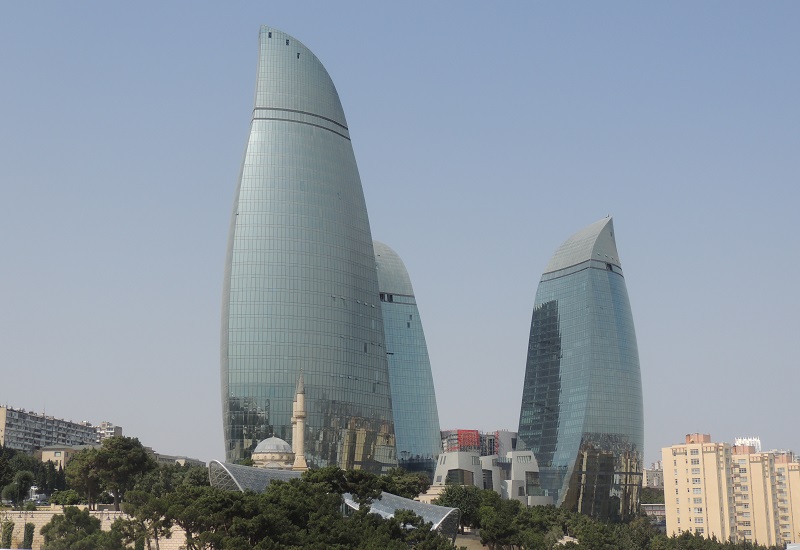
The flame towers are a skyscraper complex like no other in the world. With a height of 182 meters, the towers are among Baku’s tallest building complexes, consisting of three separate residential, hotel and office high-rises, which together form a whole like flames.
The towers, with their shape and under evening lighting with, among other things, flames on the panels of the facades, can easily live up to their name. The towers opened in 2012 after five years of construction and, in addition to the towers themselves, also contain a shopping center and an IMAX cinema. The shape of the skyscrapers comes from Azerbaijan’s fire and oil, for which the country is famous.

Baku’s metro system opened in 1967, and like other subways in the Soviet Union, the stations were in many places decorated as people’s palaces. In Baku, it happened with Soviet ideology in an Azerbaijani version and appearance.
The metro plans were laid in the 1930s, when a new city plan was outlined. After World War II, the city’s population reached one million, which according to Soviet law was a prerequisite for the construction of a metro system. Construction began in 1951, and the opening of the Soviet Union’s fifth subway was held on 6 November 1967 to mark the 50th anniversary of the Russian Revolution.
You can, for example, start a trip from the centrally located station Icheri Şaher. Some of the remarkably beautifully decorated stations are Nizami Gəncəvi, Xalqlar Dostluğu, 20 Yanvar, Əhmədli and Elmlər Akademiyası, all of which can be seen on a trip around the metro.
Archangel Michael Church is the main church of Baku’s Russian Orthodox congregation. It was built by the Russian Navy in 1850 on the occasion of the visit of Tsar Nicholas I and the Navy Commander, Alexander Tsesarevich, to Baku in 1851. For that reason, it initially belonged to the Navy and was also called the Naval Church.
The church’s architecture follows the style of Russian Pskov, and a distinctive exterior feature is the onion dome. Like the majority of Russian Orthodox churches, the interior is richly decorated with, among other things, many icons and a gilded iconostasis.
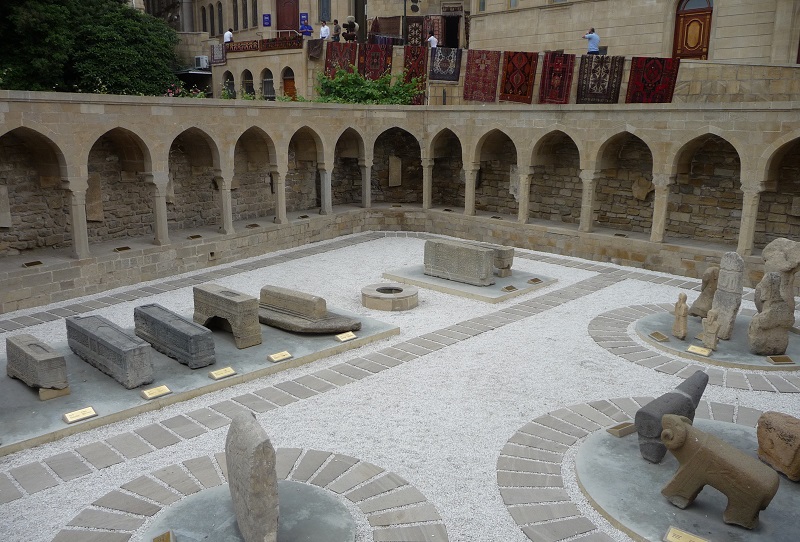
The market square in the central part of Baku’s Old Town used to be both a religious and a commercial center. Today you can see a preserved part of the former religious part, where a number of graves have been found during excavations. The facility dates from the 1200s and 1300s.
Milli Məclis is the name of Azerbaijan’s parliament, which in the country’s current period of independence has been elected since 1995. Before that, an election was held in 1990, and it was an election under the Soviet Union, when Azerbaijan’s Supreme Soviet was already discussing independence from the union state.
Milli Məclis has also existed in the past. It was in the period from the formation of the parliament on 29 November 1918 to the last session on 27 April 1920, after which the country became part of the Soviet Union.
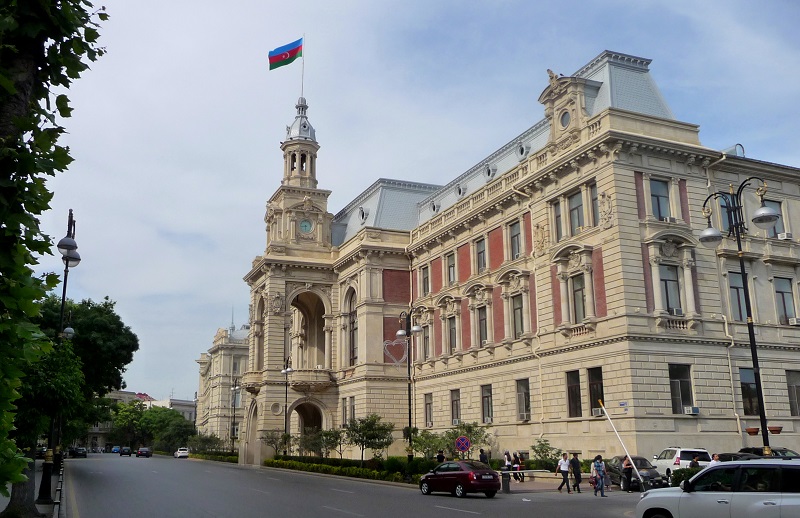
Since 1991, the City Hall in Baku has been the administration of the city’s mayor. It was built in the years 1900-1904 as a city council building, and the baroque building was inspired by Paris’ city hall, the Hôtel de Ville. The architect was Polish Josef Goslavski, who had come to Baku in 1891 after completing studies in Saint Petersburg. Goslavski’s popularity was great, and in addition to the town hall, he built mansions for two of the city’s oil barons, among other things.
From its inauguration, the building was the city’s town hall. During Azerbaijan’s Soviet era, the town hall was the seat of first the executive committee of the Baku Workers’ Council and later of the executive committee of a Chamber of Deputies. Both of these institutions functioned as city councils.
The Friday Mosque was built 1899-1901 and financed by the merchant and shipowner Haji Dadashov. It has a very fine decoration in Islamic style and a minaret, the history of which goes back to the original mosque, which used to be here from its construction around the year 1440.
During the Soviet Union, the Friday Mosque was preserved. However, its religious symbols were removed and the building was set up as a carpet museum.
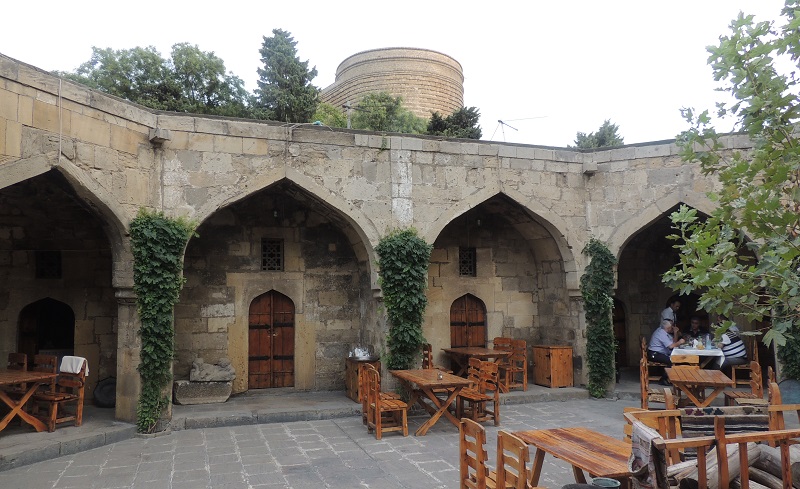
Baku used to have nine inns for overnight caravans, not least along the Silk Road. They were called caravanserai and were hostels, which was also the case with Gasim Bey Karavanserai.
This inn was built in the 17th century by and named after the owner Gasim Bey. It was built like the city’s other caravanserais with separate rooms around a central square. There were also two entrances, one of which was from the street and the other from the lake side.
The Azerbaijan Historical Museum is a museum with extensive collections spanning the earliest archaeological periods to recent times. There are several themes, for example a numismatic collection, an ethnographic department, ceramics and weapons. The countless effects thus depict the country’s history in many forms and periods.
The museum is housed in the beautiful former residence of one of Baku’s biggest oil barons in the late 19th century, named Gadji Taghijev. The house was built 1895-1902 according to the drawings of the Polish architect Josef Goslavski. The style was Italian Renaissance with a number of elegantly decorated halls which can still be admired in the historical museum. Most oil baron mansions were divided into many apartments in the Soviet Union, but Taghijev’s residence became a museum and therefore did not suffer the same fate.
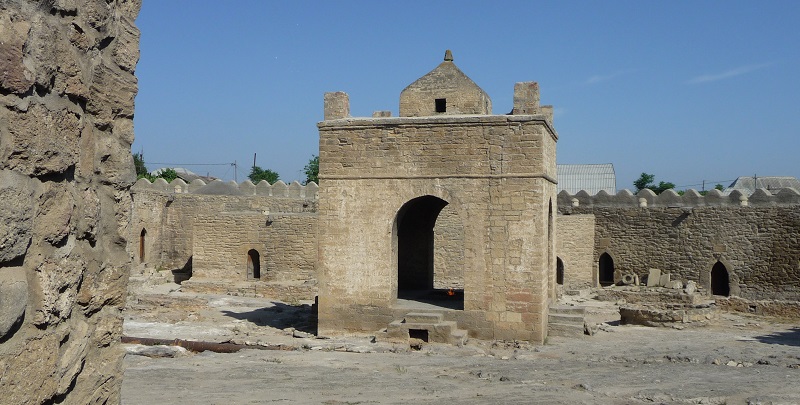
Ateshgah is a temple located in the suburb of Surakhani, whose name in Persian refers to red holes, which may have been the fire that rises from underground in the temple. Ateshgah means the place of fire in Persian, and precisely the naturally burning fire here was the reason for the establishment of the temple and the fire worship that has made it a place of pilgrimage for fire worshipers over time.
The current temple was built in the 1600s and 1800s and was used until 1883, when major oil and gas production began in the area. It was built as a pentagonal castle-like structure with a central courtyard, around which there were rooms for e.g. monks or other pilgrims who visited and spent the night on the site. In the middle stands the fire temple itself with the fire from gas in the underground. A natural fire burned until 1969, when drilling in the area drained the natural deposit. Therefore, the gas for the fire now comes in pipelines.
All around the temple, which was designated a UNESCO World Heritage Site in 1998, you can see displays of the mainly Indian travelers who came here. Inscriptions in the temple are partly in Sanskrit, but Persian is also used.
Mardakan Fort is one of many defenses located around Baku on the Absheron Peninsula. Together, the works were to form a fortification against invasion from the sea.
The fort was built in the 14th century as one of two in the city of Mardakan, and it reaches a height of 25 meters. On top of this and the other forts, fires were lit in case of danger, so that the population was warned and could prepare for a possible attack.
From the top of both the outer wall and the central tower, there is a fine view of the Caspian Sea and the area around Mardakan, which since the 19th century has provided land for the summer residences of many well-to-do people.
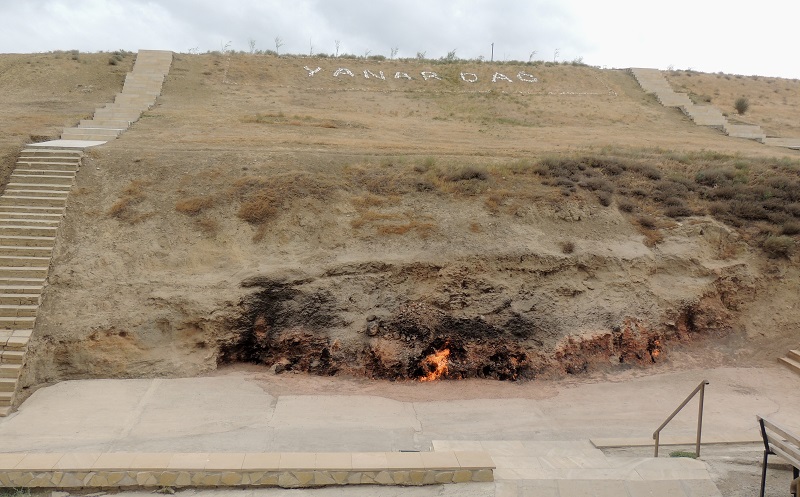
Yanar Dag means the burning mountain, which is due to the high flames that naturally rise from the cracks in the porous sandstone rocks of the place. The natural gas comes continuously out of the rocks, which distinguishes the site from, for example, the mud volcanoes in Gobustan, where rising gas mixes with water.
The fire in Yanar Dag is always burning, and according to Azerbaijani geological surveys, the up to 15 meters wide and 1 meter high flame comes from the escaping gas from a tectonic fissure about 200 meters in length.
Over time, many have described the flames from Absheron’s underground. Alexander Dumas and Marco Polo belong to them. Burning mountains are only found in a few places in the world, and Azerbaijan’s Yanar Dag is the most famous of them.
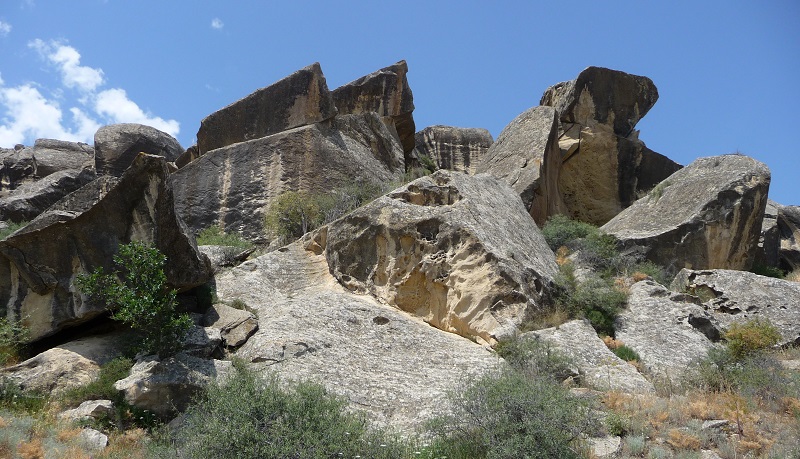
Gubustan is a city, area and national park located in a beautiful rocky landscape on the south-eastern edge of the Great Caucasus Mountains. The area is known for the many canyons that nature has carved into the mountains over time, and the huge boulders that are as if randomly thrown into the landscape.
The rock blocks gave the area’s early population shelter in the form of caves and grottoes, where they lived and executed the thousands of rock carvings that can be seen in the area. The rock carvings depict many different people, animals, scenes and things such as boats. Life in the area was then very different from today’s barren landscape. At that time, here was a rich flora and fauna that can be compared to the savannahs of Africa.
You can get an introduction to the national park and the petroglyphs at the site’s distinguished museum, which provides an introduction to both the landscape, the indigenous people, the geology of the site and, of course, the petroglyphs, which date back up to 35,000 years.
In addition to the site’s petroglyphs, there is a stone with a Roman inscription near the museum. The stone is the easternmost find of the Roman Empire’s presence, and on the stone the text reads: “IMP DOMITIANO CAESARE AVC GERMANIC I IULIUS MXIMUS LEC XII I VI”. The stone and inscription date from Roman legionnaires in the latter half of the 1st century under the Roman emperor Domitian.
The region around Baku and especially the Gobustan steppe offers the world’s largest concentration of so-called mud volcanoes, popularly speaking cold volcanoes, where the pressure of the earth sends hydrocarbon compounds from the underground and water from the Caspian Sea up through the sand with gray and bubbling mud as a result.
There are more than a thousand mud volcanoes in the world, and the largest concentration is in Azerbaijan, where a visit to the Gobustan rock carvings is just a few kilometers from an interesting sight with a number of small volcanoes bubbling freely and forming a distinctive landscape on top of a ridge.
Nobel pr. 23
Təbriz Xəlilbəyli küç 5
Neftçilər prospekti
parkbulvar.az
Lökbatan qəs.
sederek.info
Around Fontanlar Bağı, Nizami küç., Mammadamin Rasul-Zadeh
Aqua Park Shiklov
Aalyan şossesi
Azəri Televiziya Qülləsi
Abbasqulu Abbaszadə 2
Dənizkənarı Milli Park
Dənizkənarı Milli Park
Bakı Zooloji Parkı
Bakıxanov küç. 29
Kukla Teatrı
Neftçilər prospekti 36
kuklateatri.com
There have been settlements around Baku and the Absheron Peninsula since the Stone Age. In Baku itself, archaelogical finds have been dug out from the Bronze Age, which may indicate residents here already at that time.
In the century after Jesus’ birth, the Roman Empire came to this region in two periods. They have left Roman inscriptions and the village of Ramana from about the year 90 in the Sabunchu district. According to the disciple Bartholomew, the city of Albana was located here. At that time it was possibly known as Albanapolis.
According to the legend, Bartholomew converted the king of Armenia to Christianity, which resulted in the martyrdom of the disciple when the king’s brother realised this act. Bartolomeus was executed and it may have taken place at the present Virgo tower in the old town of Baku.
Sources mention Baku and the fire that rose from the earth here from nature. The earliest description is from the hand of the Greek historian Pricus, but his and other depictions of the following centuries do not mention much of the city’s development until the 9th century.
The origins of Baku’s name are not certain, but the name may have come from the Persian Bagavan meaning the City of God. Baku was also called Bagavan in the first centuries.
From around the year 1000, more details from Baku’s history are known. During that time, the city alternately belonged to Turkish and Arab Khanates, such as the Khazaria, and during that period the city was also attacked by the expanding people of present-day Russia. It came to several fights; among others, in 1170, when Shirvanshah Akhsitan I’s troops and navy fought back a Russian attack.
Over time, the Shirvan area had been established with the Shirvanshahs as leaders. From 1191 the court was relocated to Baku, which thereby became the capital. The court included several institutions such as the country’s mint.
Throughout the 1100-1300s, a number of fortifications were constructed in and around Baku. Among them was the Maiden Tower in the central city and the castle of Sabayel on an island in the Bay of Baku.
One of the city’s major challenges during the period was rising water volumes in the Caspian Sea. In addition to flooding in the city, Sabayel sank below the 13th-century waterline.
Centuries in the Azerbaijani region meant new rulers and new times. For example, during the third Mongolian invasion in the years 1231-1239, Hulagu Khan occupied the city, which in the 1300s experienced a time of flourishing under Muhammad Oljeitu.
City taxes were eased and cultural life was evolving. It was also in this period that local poet Nasir Bakui wrote a poem for Oljeitu. It was the first in Azerbaijani language.
Baku also enjoyed great growth in the trade. Leading European merchant states such as Genoa and Venice were present here, and Baku also traded with the Golden Horde, the princes of Moscow and several other European countries and peoples.
Stories about large quantities of oil arose from travelers to Baku. Between 1568 and 1574, for example, there were six English missions in the city, from which Thomas Bannister and Jeffrey Duckett described the phenomenon of both petroleum and the oil, which was locally called feather.
The area’s first real oil source was established by the standards of the time in 1594; it was in Balakhany near Baku, and in 1636 German Adam Olearius could describe Baku’s 30 oil wells.
In 1501, the Persian Safavid dynasty was established, and the same year its troops besieged Baku. In 1538, Shah Tahmasp I overcame the reigning Shirvans of the city, and the Azerbaijani Safavid era lasted until 1722, when the power of the dynasty was destroyed.
The following year, Peter the Great’s Russian soldiers came to the area, and on June 26, 1723, they won the battle for Baku. Prince Bariatianski became commander of the city defended by two regimental soldiers. Among the commands of the St. Petersburg czar was to send oil from Baku to the capital of the empire.
Russia’s troops were forced to leave Baku in 1735 following an agreement with Shirvan leader Nadir Shah, and after a few years a partially autonomous khanate was established in Baku in 1747. From that same year, the Khanate was part of the larger Quba khanate, which, like the Khanate of Baku, had arisen after the dissolution of the Safavid kingdom in 1747.
At this time, 5,000 people were living in Baku, whose economy was in dire straits despite the large amounts of oil that was eventually produced. Almost constant strife and looting had left its mark.
The Quba khanate was heavily dependent on Russian military aid, but over time Russia itself had ambitions for power in the Caucasus. In 1796, 6,000 soldiers under the command of General Zubov started the conquest of Baku, and after the fleet’s entry into the Bay of Baku, the forces were able to quickly occupy the city. In 1797, however, they left the area again for a time.
In the years 1804-1813, a war between Russia and Persia arose over the lands of the Caucasus region. The war ended with the Treaty of Gulistan, which assigned the Russian czar most of the land. Baku had already been conquered in 1806, and the city formally transferred to Russia after the end of the war.
The 19th century under Russian rule was a time when Baku’s great growth and flourishing started. New suburbs was laid out, and medieval defenses along the Caspian Sea were replaced by new port facilities. The population increased continuously, and institutions such as the city’s stock exchange were founded.
Baku did industrially well through the 19th century. In 1823, the world’s first paraffin factory saw the light of day in Baku. In 1846, the first drilled oil source in the world was put into operation, and in 1863 a petroleum plant was established.
Over the decades, the abundant oil was pumped up in still larger quantities, and it was a time when oil barons produced huge amounts of oil with the resultant growth in the economy.
The barons, among others, Musa Nagyev, Murtuza Mukhtarov and Shamsi Asadullaev, became wealthy and the oil also provided the basis for the construction of the many oil baron palaces that can still be seen along the Caspian Sea.
The population followed the activity and money in the oil industry. Thus, during the oil boom from the 19th century to the beginning of the 20th century, the city grew faster than metropolises such as London and New York.
The strong growth also led to several projects with the Baku infrastructure. In 1868, a telegraph line was opened to Tbilisi in Georgia, and 11 years later an underwater connection with Krasnovodsk opened; today’s Turkmenbashi.
Czar Alexander III came to Baku in 1883 and the trip had been by train from Tbilisi. Baku had by that time been connected to the major Russian railway network.
Oil production grew steadily, and around 1900, 95% of Russia’s oil consumption was covered by Baku’s production, and during the years of World War I, around 15% of the world’s oil was produced around the Azerbaijani city.
In the wake of the fall of the Russian czar, the Azerbaijan Democratic Republic was declared a secular and democratic state. It happened on May 28, 1918 in Tbilisi, and in the beginning Ganja was the capital instead of Baku, who was under the control of the communist Bolsheviks. In time, Baku became the capital, and in the young republic there were initiatives and results such as the founding of the Baku State University.
In February 1920, the Azerbaijani Communist Party held a congress in Baku, and they adopted a preparation for an armed revolt. On April 27, the Red Army troops entered Azerbaijan, and the next day they took Baku and began the country’s time as a Soviet Republic.
In the Soviet Union, the development of Baku continued, with the first tram line being inaugurated on February 8, 1924. Two years later, the first electric railway in the Soviet Union was opened; it connected Baku and Surakhany.
Oil production also increased, and in 1940, 22.2 million tonnes of oil were produced in Baku, representing 72% of Soviet production.
During World War II, Germany attacked the Soviet Union, and one of its objectives was to capture Baku’s oil. The plan of Operation Edelweiß was approved by Adolf Hitler on July 23, 1942, and although the German troops did not reach Baku, large defense works were constructed around the city.
Baku grew to a million, and thereby, in accordance with Soviet law, acquired a subway system. New neighborhoods and buildings were built in line with the population influx to the city. In the oil exploration, land based production was supplemented by offshore platforms in the Caspian Sea. The first platform, which was the first in the world, was built in 1947.
With the dissolution of the Soviet Union in 1991, Azerbaijan again became an independent nation and Baku continued as the country’s capital.
In recent decades, a lot of new construction has been built in the city, where the Flame Towers stand above the city as a symbol of modern Baku, the capital’s ability and the commitment to increased tourism.
In the city, many buildings have also been demolished since the Soviet era, and instead new, promenades, parks and squares have been built.
 Baku, Azerbaijan[/caption]
Baku, Azerbaijan[/caption]
Overview of Baku
Baku is the Azerbaijani capital which is beautifully located on the south coast of the Absheron Peninsula, which is surrounded on both sides by the Caspian Sea. The sea is actually a large lake that, however, seems like a sea off the coast of Baku and from the main roads along the coast.
The Baku Boulevard promenade stretches along the lakeshore, and there is always activity and wonderful outdoor life under the trees and the atmospheric lights from the lampposts. The boulevard connects not only the city and the water, but also many of the city’s sights with the old inner city as one of the gems.
About the Whitehorse travel guide
Contents: Tours in the city + tours in the surrounding area
Published: Released soon
Author: Stig Albeck
Publisher: Vamados.com
Language: English
About the travel guide
The Whitehorse travel guide gives you an overview of the sights and activities of the Canadian city. Read about top sights and other sights, and get a tour guide with tour suggestions and detailed descriptions of all the city’s most important churches, monuments, mansions, museums, etc.
Whitehorse is waiting for you, and at vamados.com you can also find cheap flights and great deals on hotels for your trip. You just select your travel dates and then you get flight and accommodation suggestions in and around the city.
Read more about Whitehorse and Canada
Canada Travel Guide: https://vamados.com/canada
City tourism: https://visitwhite-horse.ca
Main Page: https://www.vamados.com/
Buy the travel guide
Click the “Add to Cart” button to purchase the travel guide. After that you will come to the payment, where you enter the purchase and payment information. Upon payment of the travel guide, you will immediately receive a receipt with a link to download your purchase. You can download the travel guide immediately or use the download link in the email later.
Use the travel guide
When you buy the travel guide to Whitehorse you get the book online so you can have it on your phone, tablet or computer – and of course you can choose to print it. Use the maps and tour suggestions and you will have a good and content-rich journey.


Baku’s metro system opened in 1967, and like other subways in the Soviet Union, the stations were in many places decorated as people’s palaces. In Baku, it happened with Soviet ideology in an Azerbaijani version and appearance.
The metro plans were laid in the 1930s, when a new city plan was outlined. After World War II, the city’s population reached one million, which according to Soviet law was a prerequisite for the construction of a metro system. Construction began in 1951, and the opening of the Soviet Union’s fifth subway was held on 6 November 1967 to mark the 50th anniversary of the Russian Revolution.
You can, for example, start a trip from the centrally located station Icheri Şaher. Some of the remarkably beautifully decorated stations are Nizami Gəncəvi, Xalqlar Dostluğu, 20 Yanvar, Əhmədli and Elmlər Akademiyası, all of which can be seen on a trip around the metro.
Archangel Michael Church is the main church of Baku’s Russian Orthodox congregation. It was built by the Russian Navy in 1850 on the occasion of the visit of Tsar Nicholas I and the Navy Commander, Alexander Tsesarevich, to Baku in 1851. For that reason, it initially belonged to the Navy and was also called the Naval Church.
The church’s architecture follows the style of Russian Pskov, and a distinctive exterior feature is the onion dome. Like the majority of Russian Orthodox churches, the interior is richly decorated with, among other things, many icons and a gilded iconostasis.

The market square in the central part of Baku’s Old Town used to be both a religious and a commercial center. Today you can see a preserved part of the former religious part, where a number of graves have been found during excavations. The facility dates from the 1200s and 1300s.
Milli Məclis is the name of Azerbaijan’s parliament, which in the country’s current period of independence has been elected since 1995. Before that, an election was held in 1990, and it was an election under the Soviet Union, when Azerbaijan’s Supreme Soviet was already discussing independence from the union state.
Milli Məclis has also existed in the past. It was in the period from the formation of the parliament on 29 November 1918 to the last session on 27 April 1920, after which the country became part of the Soviet Union.

Since 1991, the City Hall in Baku has been the administration of the city’s mayor. It was built in the years 1900-1904 as a city council building, and the baroque building was inspired by Paris’ city hall, the Hôtel de Ville. The architect was Polish Josef Goslavski, who had come to Baku in 1891 after completing studies in Saint Petersburg. Goslavski’s popularity was great, and in addition to the town hall, he built mansions for two of the city’s oil barons, among other things.
From its inauguration, the building was the city’s town hall. During Azerbaijan’s Soviet era, the town hall was the seat of first the executive committee of the Baku Workers’ Council and later of the executive committee of a Chamber of Deputies. Both of these institutions functioned as city councils.
The Friday Mosque was built 1899-1901 and financed by the merchant and shipowner Haji Dadashov. It has a very fine decoration in Islamic style and a minaret, the history of which goes back to the original mosque, which used to be here from its construction around the year 1440.
During the Soviet Union, the Friday Mosque was preserved. However, its religious symbols were removed and the building was set up as a carpet museum.

Baku used to have nine inns for overnight caravans, not least along the Silk Road. They were called caravanserai and were hostels, which was also the case with Gasim Bey Karavanserai.
This inn was built in the 17th century by and named after the owner Gasim Bey. It was built like the city’s other caravanserais with separate rooms around a central square. There were also two entrances, one of which was from the street and the other from the lake side.
The Azerbaijan Historical Museum is a museum with extensive collections spanning the earliest archaeological periods to recent times. There are several themes, for example a numismatic collection, an ethnographic department, ceramics and weapons. The countless effects thus depict the country’s history in many forms and periods.
The museum is housed in the beautiful former residence of one of Baku’s biggest oil barons in the late 19th century, named Gadji Taghijev. The house was built 1895-1902 according to the drawings of the Polish architect Josef Goslavski. The style was Italian Renaissance with a number of elegantly decorated halls which can still be admired in the historical museum. Most oil baron mansions were divided into many apartments in the Soviet Union, but Taghijev’s residence became a museum and therefore did not suffer the same fate.
Similar to Baku Travel Guide
